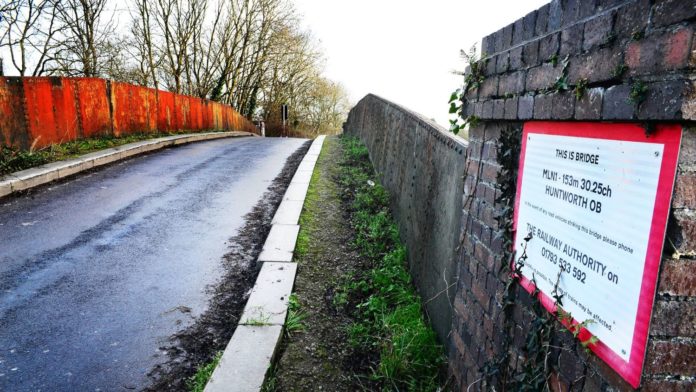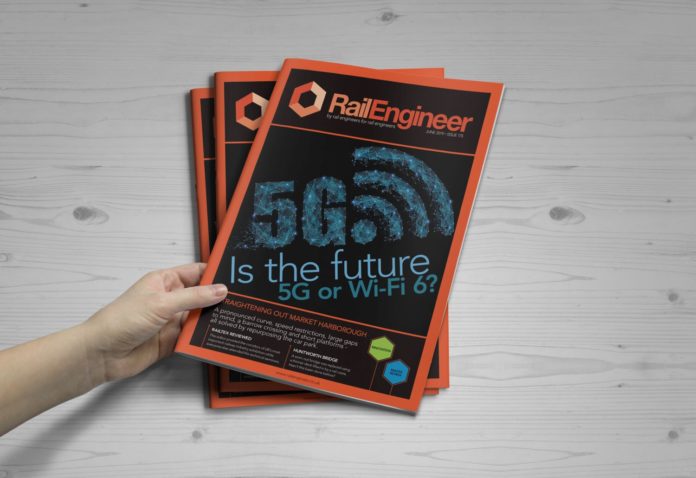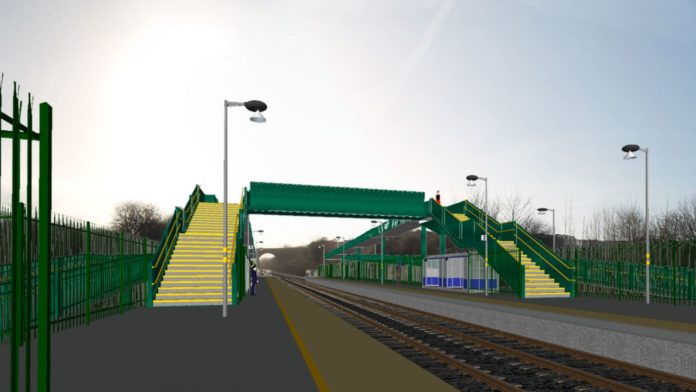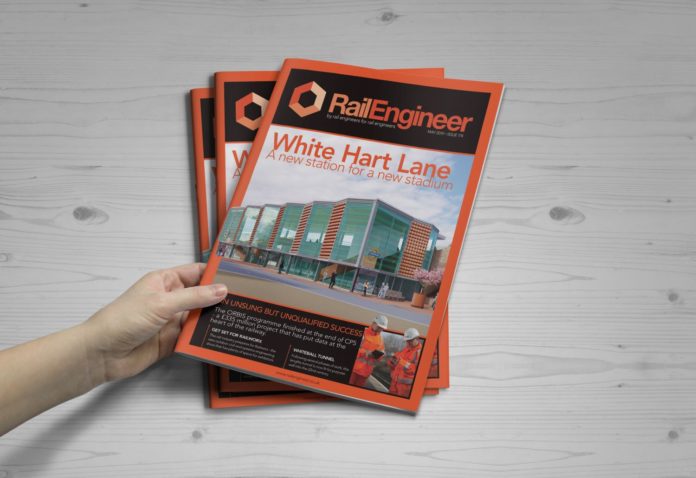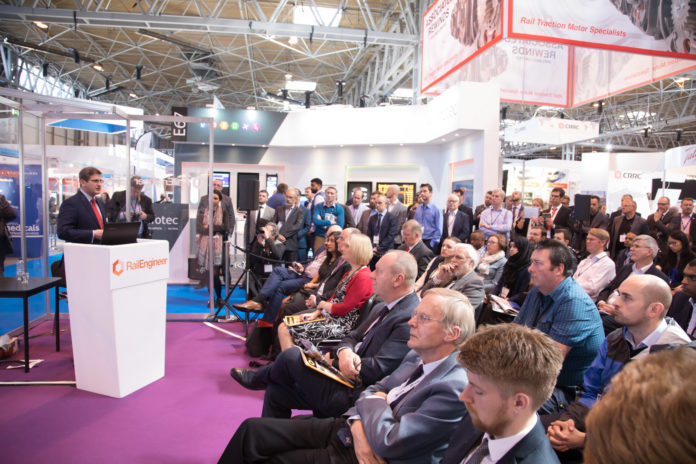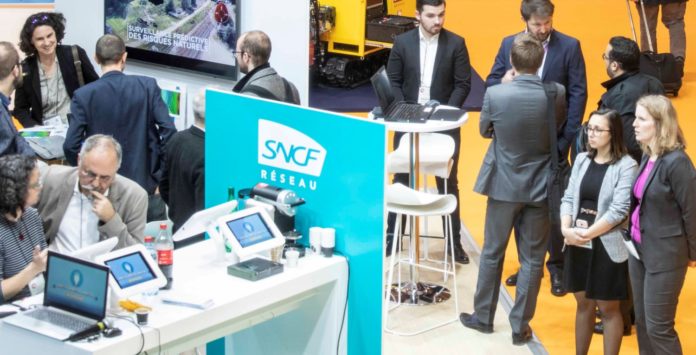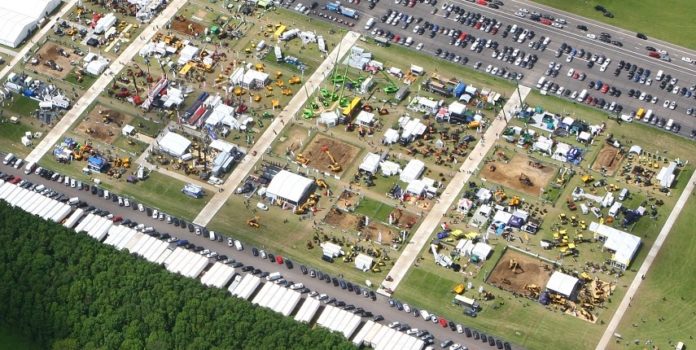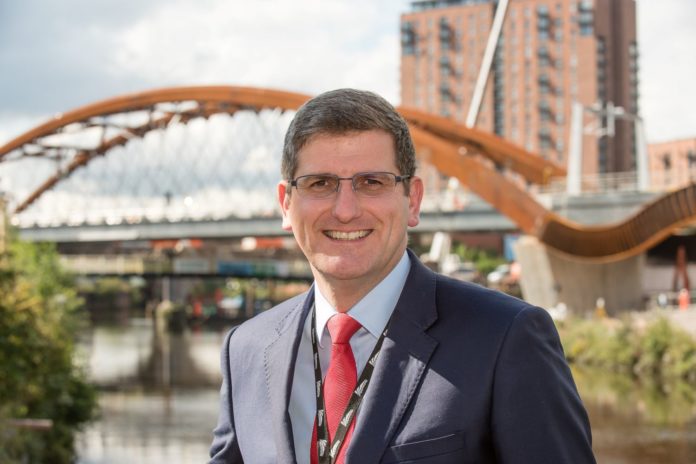For three days in May, the rail industry’s showcase that is Railtex filled the 20,000 square metres of the National Exhibition Centre’s halls 3 and 3a. With over 420 stands from 22 countries, there was much to see. Indeed, it is perhaps only such trade exhibitions that show the huge variety of products and services needed to run a railway.
With so many stands, the opportunity to chat with friends and colleagues and to attend almost 70 seminars and presentations, including those run by Rail Engineer, a day at Railtex soon passes. The result is a full bag of promotional material and freebies, much learnt and sore feet. What follows is a description of the stands that caught your editor’s eye, an unashamedly arbitrary selection of exhibitors, to illustrate what I learnt and give a flavour of the show.
The large area with orange sleepered track displaying the latest rails that British Steel have to offer couldn’t fail to catch the eye. This included their Zinoco® coated rail, which provides corrosion protection in aggressive environments such as coastal areas. Although this has been around for a few years now, it is now available in longer, 216-metre lengths.

Also difficult to miss was the large stand of Chinese rolling stock manufacturer CRRC, which is the world’s largest supplier of rail rolling stock. The stand had models of all types of rolling stock ranging from wagons to high-speed trains. I spoke to a wagon engineer who advised that CRRC had benefited from the huge increase in rail freight between China and Europe and that the company was developing a bogie that can change gauge between standard and Russian gauge. He also advised, in the UK, CRRC was to supply London Underground with 71 wagons for engineering work.
Saving carbon
A much smaller rolling stock company is Vivarail which, in 2015, took delivery of hundreds of coaches of surplus London Underground sub-surface D78 stock for conversion to affordable rolling stock on low-speed regional rail routes. On their stand, it was fascinating to talk to the company’s chairman, Adrian Shooter, who explained that the Class 230 was, essentially, a brand-new train of a modular design. The DEMU variant has two 180hp powerpack modules, whilst the motor cars of the battery variant have a 200kWh battery, giving the train a 60-mile range.

Hoppeke supply both the batteries for the train and its recharging system. On their stand it was explained that Vivarail’s battery train is recharged in seven-minutes from short sections of third and fourth-rail that are only energised when the train is over them. This charging system does not need a high-current power supply as the recharging rails are fed by a bank of lead acid batteries that provide the heavy recharging current and only need a trickle-charge.

Alstom were displaying a model of their Breeze hydrogen train concept, which provides another alternative to diesel trains. This will use surplus Class 321 EMUs for a UK variant of their hydrogen-powered iLint train, which is in service in Germany. Alstom’s Mike Muldoon emphasised that these trains were only suitable for rural routes, for which discussions are being held with various interested parties. It seems likely that the UK could see a few small fleets of hydrogen trains in a few years’ time.
The most prominent exhibit on the MTU stand was their hybrid power pack. This has a 390kW diesel engine and a traction motor with a peak power of 270kW, powered from a separate battery pack. MTU have been testing hybrid drives on the continent and have achieved fuel savings of between 15 and 25 per cent. Working with Porterbrook, MTU is to trial this hybrid drive on a Class 170 DMU next year.
Turbo Power Systems (TPS) was the only stand I saw that promoted use of silicon-carbide power electronics, a recent development offering higher power density, greater conversion efficiency and less waste heat. These were being used in the compact, naturally cooled unit 13.5kW auxiliary power supply unit they had on display that TPS is developing for London Underground’s new Central line stock.

Unusual components
An unusual feature of the wheelset on display on the Lucchini Unipart Rail (LUR) stand was that one wheel was a freight wheel and the other a passenger wheel – the difference between them being that, unlike the passenger wheel, the freight wheel disc has a curved cross section which reduces track impact from the harder suspension of freight vehicles. The wheelset had a radio frequency identify (RFID) tag to easily identify individual wheelsets and their history. Its axle was also coated with a 4mm-thick Lursak impact protection coating.

From underneath to the top of a train, Wabtec’s stand featured the intelligent pantograph that has been under development for some time – indeed, it won an innovation award at the 2014 RIA innovation conference. This pantograph uses a fibre-optic cable to measure real-time wire contact force and so can monitor the overhead line equipment. It has been trialled on the high-output electrification train for a year and will be fitted to a Class 90 locomotive later this year, after which approval for general use is expected.
The various odd-shaped ducts and other components produced by 3D printing (or, to use the more accurate term, fused deposition modelling) on the Stratosys stand showed the design freedom this technique offers as well as its ability to produce lightweight components. Further evidence of its potential is that the required 3D model can be produced within a week, compared with about eight weeks for a traditional mould. I learnt that one application is producing lightweight tools for the aero industry which cause no harm if dropped.
Train Bits and More is an intriguing company name which attracted me to its stand where I learnt that the company offers train servicing including on-site toilet tanks cleaning and seat cover dry cleaning. It also offers powder-coating of internal fixtures using the highly durable Omnikote Nylon R-AG+ process.
A motorbike powered by a steam jet to accelerate it at 50 mph per second certainly attracted visitors to the IMI Precision Engineering stand. Although the bike uses some of the precision valves produced by the company, it was built by Graham Sykes performance engineering.

Samuel Taylor Ltd (STL) also make small railway components, or rather parts for components in the form of contacts used in switches and relays. They had a wide range of these tiny parts to display in this specialist engineering field. With many signalling relays still in use, it will be some time before the digital railway reduces demand for their product, especially as rail accounts for only five per cent of STL’s business.
Silver Fox also produces small electrical parts in the form of cable labels which it can produce in the form of ladders of heat shrinkable tubes that can easily be removed for fitting onto cables. It offers specialist software to prepare and print labels.
Sensors and earthworks
Both Acorel and Dilax offer rolling stock sensors to detect and count passengers. Each company offers software to analyse passenger flows for passenger counting and offered case studies explaining the benefits of monitoring passenger number and flows.

Trimble Nexala Solutions specialise in measurement, the collection of data and its analysis. For rolling stock, it uses data-processing algorithms to get effective use of data from train sensors and its automatic wayside train inspection systems that use sophisticated machine vision and non-contact measurement technologies. This provides remote diagnostic information that can be used for pre-emptive maintenance and is used by many UK train operators including South Western Railway, Eurostar, Arriva and Greater Anglia.

This information was also one of the data sets for the Data Sandbox research referred to in our “Enabling better performance” feature in this month’s magazine
Also on the Trimble stand was its GEDO Scan System, which gathers high-resolution data about track and surrounding features. It has a helical scanning mode to capture ceilings and walls to produce accurate 3D models of tunnels and overpasses. This is a productive tool for track surveys and incorporates GPS, inertial measurement and related sensor technologies. The integration of rugged hardware with customized software can compute indicative track design with continuous smooth horizontal, vertical and cant alignment. It can also create cross-section drawings, automatically detect gauge infringments and calculate OLE heights and staggers.
Battery-powered sensors to detect earthworks movement are amongst those produced by Findlay Irvine. 7,000 of their wireless tilt sensors have been installed at 180 sites on the UK network. When a site alarm is triggered, day/night cameras transmit a site image for an operator to determine what, if any, mitigation action is required. These sites are currently under trial and full approval of this system is expected soon.
US company Propex was offering its Armormax engineered earth armouring system as a way of preventing such earthworks failures. This reinforces natural vegetations and so costs less than traditional concrete and rock solutions. Although their system is widely used in the United States, this system has yet to be used on a UK railway, so the company hoped that their cost-effective, environmentally friendly solution would attract interest at Railtex.
One innovative earthworks technique that does have product approval is Concrete Canvas, which is a flexible geosynthetic cementitious composite mat which is essentially concrete on a roll and is often used for channel lining and erosion control. An 8mm concrete canvas has the same strength as 100mm of reinforced concrete. Also, one bulk roll is equivalent to the concrete supplied by two 17-tonne mixer truck.

My visit to the Lindapter stand convinced me that I was wrong to think that bolting steelwork together is simple matter. Many railway projects have the complexities of adding modern steelwork to historic structures, for which the company has developed its innovative steelwork connectors.
Of course, a lot of railway engineering work takes place at night. That used to mean at least one generator and a cluster of powerful floodlights. Now, with LEDs, batteries can be used as they are both silent and environmentally friendly. Even hydrogen fuel-cells can be brought into play.
So it was interesting to see Peli’s area lighting systems, which now feature an ‘intelligent control’ panel. This adjusts the light output according to the length of light duration required and provides a real-time display. Just set the hours and minutes (maximum is 24 hours – minimum 6 hours) of light required and the unit will calculate and adjust the output.
Sales manager David Smith explained it to me: “We have harnessed the new technology to develop a smarter product within the overall design of the existing unit. This real time display allows the user to plan their time and shifts accordingly. The importance of the intelligent control system shouldn’t be underestimated as it enhances user safety and ensures jobs can be completed every time without plunging sites into darkness.”
Telent, with more than 30 years’ experience of successfully delivering and maintaining communication systems for the rail sector, is perfectly positioned to deliver the innovative digital technologies that are so important to ensure the UK’s congested rail networks run smoothly and to create smarter, more reliable services

At Railtex, Telent presented Arbitex, a remote CCTV-monitoring platform, reduces maintenance costs and increases asset reliability that is already in operation for Transport for London and is currently being implemented as part of Telent’s major stations CCTV contract with Network Rail. This solution was exhibited alongside MICA, which enhances communication, Supervisory Control and Data Acquisition (SCADA) and building management subsystems, integrating CCTV, public address systems, passenger information displays, help points, fire and intrusion detection systems and more.
TRAMMS – Telent’s end-to-end maintenance management system – enables the monitoring and measurement of fault levels and trends across a wide range of assets in many environments.
Together, the tools are at the heart of Telent’s Reliability Centred Maintenance methodology and have a proven track record in helping the UK’s rail networks increase asset reliability, reduce customer costs and improve operational efficiency.
Level crossings

From bolts to hinges, the Mk III Hinge of the Aluminium Lighting Company (ALC)’s Echalon column enables it to be easily and safely lowered by one person. These columns can be up to eight metres high and, in a collaboration with SEA, are now used to carry the ROADflow signal system that detects cars that fail to comply with stop signals at level crossings. By the end of July, 88 columns with this equipment are expected to have been installed on South Eastern and Anglia routes.
Signs at level crossings and on Network Rail’s infrastructure are produced by Britain’s Bravest Manufacturing Company, which is a social enterprise of the Royal British Legion. The company is Network Rail’s only approved supplier of trackside signage. It also provides great employment opportunities for people with disabilities and injured ex-service personnel who make up 70 per cent of their workforce.
One risk at level crossings is the flange gap – a safety hazard for cyclists and wheelchair users. Strail’s veloSTRAIL eliminates this hazard. This incorporates an easily replaceable flangeway element which butts against the rail head and deforms when a wheel flange passes over it. It is approved for use for trains up to 75mph (120km/h). As it is intended for use with conventional track, it is not suitable for tram tracks.
A novel method of train detection at level crossings, displayed on the Wavetrain Systems stand, uses a complex algorithm to analyse the signal from an acoustic sensor to activate the crossing at the required time. The system is CENELEC SIL 2 certified by Lloyds Register, based on lab testing in Norway and field tests in UK, Norway, Finland, France, South Africa and Australia. It is expected to receive approval by Network Rail soon. As the system is independent of the signalling system and can be installed within 20 metres of the crossing, it offers low-cost detection. It also provides a more consistent warning time than sensors activated at a fixed distance from the crossing.
Supporting UK rail
To help rail sector suppliers understand opportunities outside the UK, the Railway Industry Association (RIA) and the Department for International Trade (DIT) jointly ran a series of pre-arranged 20-minute business focused meetings between interested companies and the DIT trade experts covering the rail sector based in British Embassies/High Commissions around the world. These covered fifteen countries including India, Kenya, Canada and the UAE.
One group of countries, the Baltic states, had its own stand. Rail Baltica is a new 870km rail line which will integrate the Baltic states with the European rail network. The project is now in its design phase and the new line, which will connect Tallinn to Warsaw, is expected to open in 2026.
Another stand that supports the industry was that of the Birmingham Centre for Railway Research and Education (BCRRE), which is the largest university-based centre for railway research and education in Europe. Their stand featured various research work, including that from its Centre of Excellence in Digital Systems, which is part of the UK Rail Research Innovation Network (UKRRIN).

During Railtex, I naturally saw much of the Rail Media stand to rest my feet, have a coffee and store promotional material from the stands. During the show my colleagues on the stand gave out 2,500 magazines – we like to think that this supports the industry by highlighting good work done and providing features about current developments.

Railtex itself also provides a valuable service by showcasing products and services, providing an opportunity for people from throughout the industry to meet face to face, make connections and do business. One good example was the Recruitment Wall, powered by Railway People, which was encouraging people to find employment in the rail industry as well as discussing job opportunites with xhibitors and visitors alike.
Of necessity, this perspective of the show is only a small part of it and omits many other worthwhile products and services. Do get in touch if you have an interesting story about an innovative product that we missed at Railtex.
Rail Engineer looks forward to seeing what’s new at Railworx in Peterborough on 11 to 13 June and at Infrarail in Olympia on 12 to 14 April next year.



